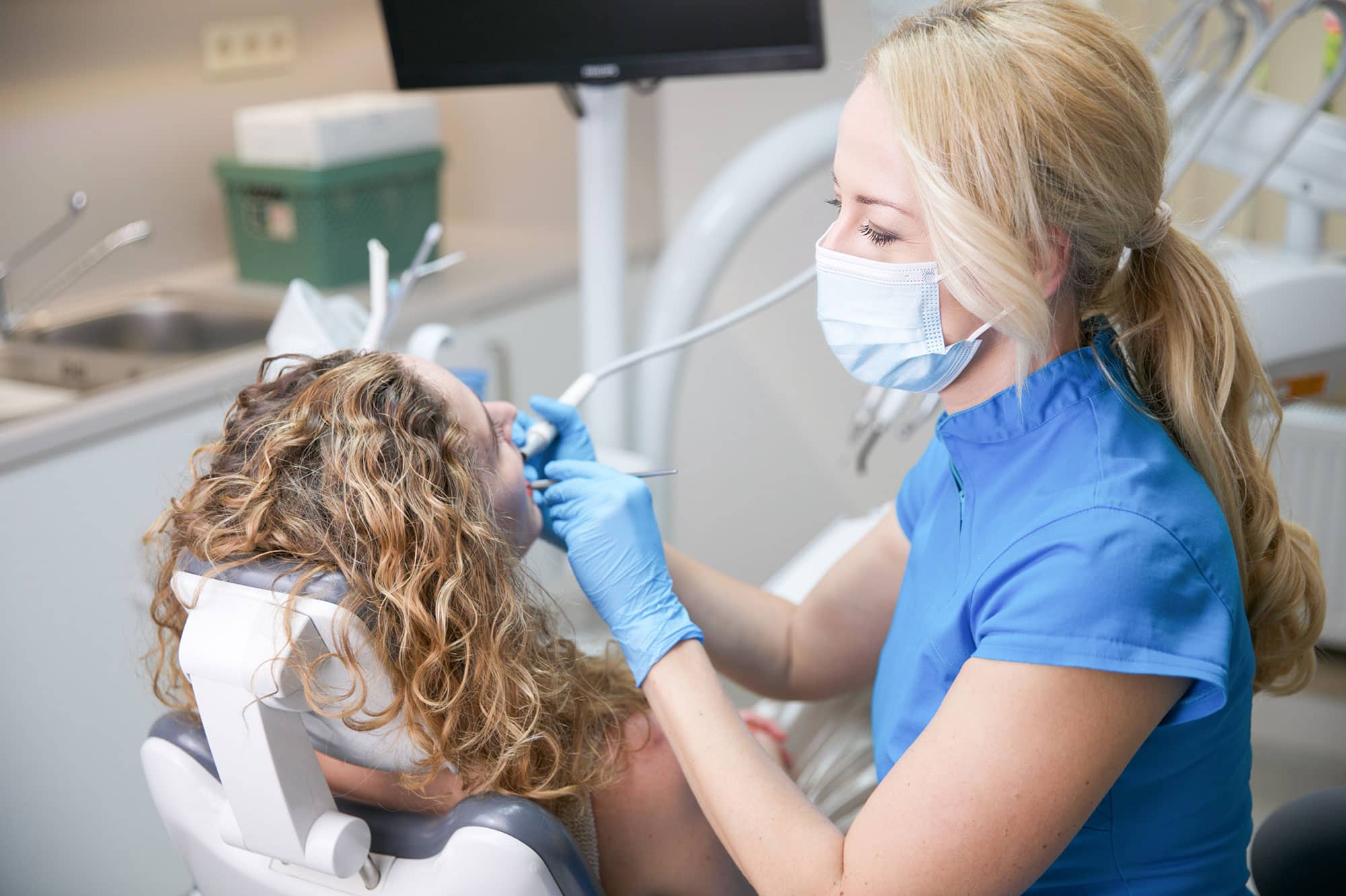In certain cases, a bone graft surgery must be performed before the placement of dental implants. Although it sounds frightening, it is a routine procedure involving minimal intervention. During the bone graft, the missing bone volume in the jaw is replaced. This allows us to ensure a solid foundation for the dental implants. This article is aimed at patients who are planning dental implantation but may also need a bone graft and who wish to understand the procedure, its potential risks, and the healing process in order to prepare for the treatment with more confidence.
In our article, we cover the following topics: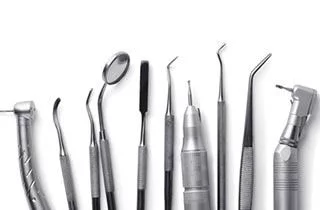
- Reasons and symptoms of bone defects. Reversal of process
- Main types of bone grafting
- A special bone grafting is lifting the base of maxillary sinus (Sinus lift)
- Process of bone grafting
- Dental bone graft complications. Possible risks of bone grafting
- Advice on mitigating complications after bone grafting for dental implants.
Reasons and symptoms of bone defects. Reversal of the process
Bone deficiency can be caused by, among other things, long-term wearing of Dentures , advanced periodontal disease, or tooth loss due to an accident. Smoking also represents a serious risk factor for this condition.
Initially, the damage is hardly noticeable, as Bone Loss is generally not accompanied by significant pain. The main symptoms of advanced bone loss are the following: bleeding gums, sensitive, swollen gums, bad breath, loose teeth, and decreased biting strength.
Thanks to the bone graft, if our body accepts the new material, the development of new, living bone can begin after the procedure. The strong jaw enables the performance of other surgical procedures, e.g., the Placement of the Implants.
Main types of bone grafting

The bone used in the bone graft is of human or synthetic origin. The bone of human origin can come from the patient’s own body or from a donor. The specialist decides on the type of bone graft in each case, taking into account the consultation with the patient and the condition of the sick person. The doctor considers all important backgrounds and also conducts physical examinations before the surgery.
The types of bone grafts can be distinguished as follows. In the listing, we mention in advance some risk factors as well as the advantages of the respective method.
Bone grafting with your own bone
In this case, bone is taken from another part of the patient’s body. Afterwards, it is attached to the location where the bone needs to be built up. From the perspective of complete recovery and for reducing the risks of rejection, bone graft with one’s own bone is generally the safest solution.
Bone grafting with a donor
The donor can be another living or deceased person or even an animal. An undeniable advantage is that multiple surgeries do not have to be performed on the patient simultaneously. Thus, the risk of infections decreases. Naturally, during bone graft with a donor, the bone to be used undergoes strict examinations beforehand. Then it is impregnated with antibiotics and treated with substances that accelerate bone formation.
Bone grafting with synthetic materials
Thanks to the constant development of surgical technology, we have synthetic materials of excellent quality available today. A proven advantage of the synthetic material is that it contains no living cells. Therefore, the risk of rejection is minimal. Since the bone used during the bone graft contains no living bone marrow, it is also not necessary for the blood types of the donor and recipient to match. These materials are broken down biologically very well and are thus extremely safe. In some cases, however, it can happen that the body accepts them with more difficulty.
A special bone grafting is lifting the base of the maxillary sinus. (Sinus lift)
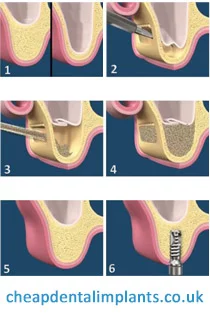 If the Upper Jaw in the area of the lateral teeth proves to be too thin, lifting the sinus floor may become necessary.
If the Upper Jaw in the area of the lateral teeth proves to be too thin, lifting the sinus floor may become necessary.
Here, the upper jaw is opened towards the sinus. The covering mucous membrane on the surface of the sinus is surgically opened. Then it is gently lifted upwards. This creates a cavity into which the bone graft material is inserted. Thanks to this surgical procedure, the bone layer of the upper jaw becomes thicker during the recovery period. This allows for the direct placement of the dental implant. More about Sinus Lift.
Process of bone grafting
Before the surgical procedure, your doctor conducts the necessary examinations and learns about your medical history. Afterwards, he makes the decision about the type of bone graft in agreement with you. The specialist informs you about all the details of the procedure. The bone graft is performed, of course, with anesthesia. Thus, the patient feels no pain during the procedure.
Depending on the chosen procedure, the surgeon makes the necessary incision or incisions, then performs the implantation with the chosen material. Finally, he closes the surgical area. After the surgery, the doctor gives the patient all necessary instructions. Later, he conducts a follow-up examination and, if needed, an implantation procedure. It also happens that the bone graft procedure and the implantation are performed at the same time.
How long does it take to heal after bone grafting?
The healing time after a bone graft depends on many factors:
The Surface area of the bone structure: The larger the volume of bone to be built up, the longer the healing typically takes. The Type of Bone Graft Material used: Synthetic materials heal faster than the body’s own bone material. Individual healing ability: Every person heals at a different speed. In smaller cases: The recovery phase can be completed after a few weeks, but in major procedures, recovery can take up to six months or longer.
Dental bone graft complications. Possible risks of bone grafting
Thanks to innovations in modern medicine, complications can be significantly reduced in many cases, even if individual variations can occur. However, this surgical procedure, like all other medical interventions, can carry some risks.During Bone Graft , in addition to the usual complications of surgical procedures (e.g., bleeding, risk of infection, poor reaction to anesthesia), one can expect the following side effects.
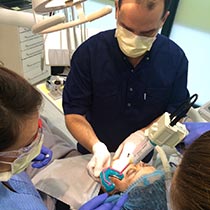
- pain,
- swelling,
- nerve damage,
- implanted material gets rejected,
- inflammation, Periimplantitis
- absorption of implanted material,
How do you recognise periimplantitis?
Peri-implantitis is an inflammation of the tissue surrounding a dental implant. Symptoms: The gums around the implant can be red, swollen, and sensitive, and they may bleed even with light pressure. Pain can occur, especially when chewing, but an unpleasant taste in the mouth can also indicate inflammation. In advanced stages, pus may form. In severe cases, loosening of the implant can occur.
Is periimplantitis curable?
Peri-implantitis is curable: Typically, it can be treated with antibiotics and a thorough cleaning of the gum pockets by a dentist. Advanced peri-implantitis may require surgical intervention.
Most symptoms of the side effects occurring during the surgeries can be treated and alleviated very well. In more severe cases, the material used in the bone graft is rejected or it does not develop properly with the other bones. In these cases, it may happen that after the Surgery a further procedure becomes necessary. In this, the previously placed material is first removed, then a new bone graft is performed on the patient. In our concluding chapter, we provide useful tips for alleviating the symptoms of the side effects that usually occur during bone graft. Bone Graft Upper and Lower Jaw- Experiences
Advice on mitigating complications after bone grafting for dental implants.
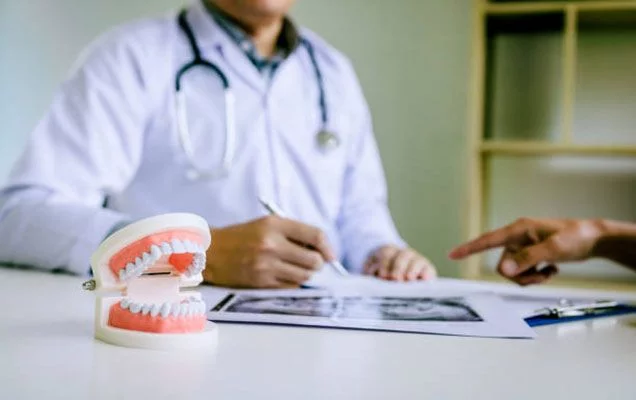 Medicine
Medicine
Like any surgery, bone graft is accompanied by unpleasant sensations. The treatment is performed under local anesthesia during the procedure, so most patients feel only minimal discomfort. It is similar to the pain of tooth extraction. The anesthesia before the surgery and the anti-inflammatory medication prescribed by the doctor help to bear the pain and aid in the healing of the surgical area.
Chilling
Bone graft is generally accompanied by swelling. Besides medication, ice therapy is particularly useful during the post-operative period, as it reduces the swelling and bleeding, while also alleviating the pain.
Diet
As long as the anesthetic is still effective, you should not eat or drink. In the days following the bone graft, it is very important to follow the diet prescribed by the doctor. The diet is individually tailored. Generally speaking, during this time one should avoid foods that require a lot of chewing, are crunchy, or are hard. You should refrain as much as possible from consuming coffee, tea, and alcohol. If someone suffers from diseases with natural bone loss, smoking is also strictly forbidden.
During the period after the bone graft, cold liquids and fruit juices are good. The consumption of various soups and mixed drinks is also recommended. Other foods that do not require strong chewing, e.g., mashed potatoes, oatmeal, scrambled eggs, pudding, can be consumed according to the doctor’s prescriptions.

Sleeping
After the bone graft, patients should sleep on their backs if possible. Place pillows under your head; this can reduce the risk of bleeding in the surgical area. If sleeping on your back is problematic, turn onto the side opposite the surgical area.
Lifestyle
In the first days after the bone graft, you should get as much rest as possible. Avoid strenuous activities.
Dental care
Use soft toothbrushes for the care of your teeth during the post-operative period. Read more about Proper Oral Care
Others
In case of any unexpected, excessive, or extraordinary complication, or for any other questions not covered in this article, you should confidently contact your treating physician. Further advice on Prevention of Bone Loss and on the Bone Graft Healing Process
What if the bone graft does not work?
It is important to know that even with bone grafting, success is not always guaranteed. Implants cannot be placed: Without sufficient bone support, dental implants cannot be safely placed. Treatment time is prolonged or fails: If the bone transplantation is not successful, another procedure must be planned, which prolongs the entire treatment time. Increased costs: Additional procedures lead to higher treatment costs. Psychological stress: An unsuccessful bone reconstruction can be frustrating and stressful for the patient. From our article, it is clear that there is an appropriate solution for healing the injured jaw. Thanks to modern technology, even with more severe damage, one does not have to forgo the appropriate restoration of the gap-toothed dentition.

